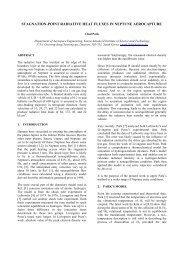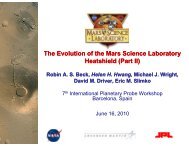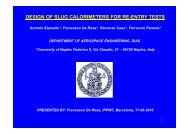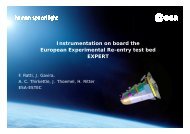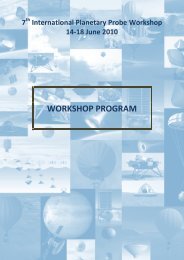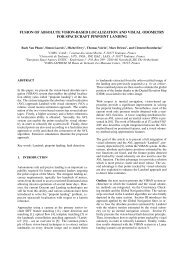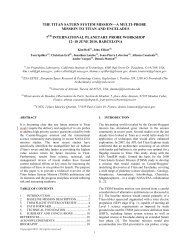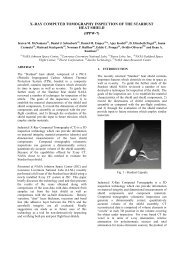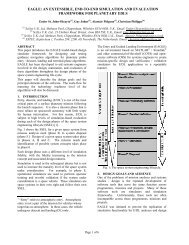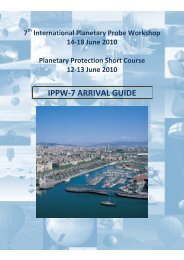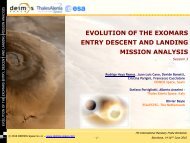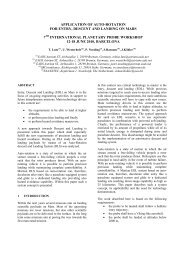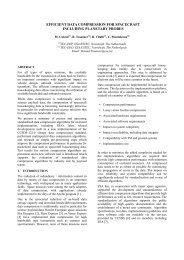Paper 423 - International Planetary Probe Workshop
Paper 423 - International Planetary Probe Workshop
Paper 423 - International Planetary Probe Workshop
Create successful ePaper yourself
Turn your PDF publications into a flip-book with our unique Google optimized e-Paper software.
As a result, alternative parachute housings are being<br />
investigated.<br />
1.7 Aeroshell Geometry<br />
In order to select the proper geometry for the entry<br />
vehicle, or aeroshell, a quantitative survey of four<br />
possible geometries was completed. Several factors<br />
were taken into account, including the vehicle drag<br />
coefficient, the expected heating range, the initial<br />
orientation requirements, the stability in all flight Mach<br />
regimes, the terminal descent architecture, overall<br />
complexity, and finally the flight heritage. After all<br />
considerations, the Mars Microprobe 45 degree<br />
spherecone geometry was selected because of its<br />
excellent stability, its flight heritage, and its overall<br />
complexity. However, because the Microprobe<br />
geometry has a larger volume distribution in its<br />
spherical portion, difficulties will arise when trying to<br />
move the center of gravity forward. This will be<br />
accounted for in the entry vehicle packaging. Table 2<br />
in the appendix shows the factors considered for the<br />
four geometries considered (Mars Microprobe, Sphere,<br />
CEV, and Stardust). Figure 6 below shows a packaging<br />
model of the current entry vehicle design. The<br />
parachute is modeled within a canister, which will<br />
change when a suitable alternative is found. The<br />
insulating shell exists in order to insulate the science<br />
payload from the heat dissipated from the Thermal<br />
Protection System (TPS).<br />
flight path angle. Based on these results SIRCA is the<br />
best candidate material for the heatshield and LI-2200<br />
is the best material for the backshell based on both<br />
mass and volume.<br />
Table 3. Initial TPS sizing results.<br />
Un-‐margined <br />
Thickness (in) <br />
PICA SIRCA LI2200 <br />
Stagnation 0.664 0.315 x <br />
Frustum 0.548 0.254 x <br />
Back shell 0.310 0.134 0.114 <br />
Assumptions <br />
Nose Radius 0.1 m <br />
Velocity 7.6 km/s <br />
FPA -‐3 deg <br />
<strong>Probe</strong> Mass 6.88 kg <br />
Initial Temp 70 F <br />
Base Radius 0.267 m <br />
Cone Angle 45 deg <br />
Reference Info <br />
Peak Heating <br />
(stag) 191 W/cm^2 <br />
Peak Pressure <br />
(stag) 6.26 kPa <br />
Heat Load (stag) 9650 J/cm^2 <br />
2. SCIENCE REQUIREMENTS<br />
Figure 6. Current packaging model of entry vehicle<br />
1.8 TPS Selection<br />
A preliminary trade study of TPS material selection has<br />
been performed using the initial mass and geometry<br />
estimates for the parachute reference configuration and<br />
the -3 to -4 flight path angle. The TRAJ trajectory tool<br />
was used to define the ballistic trajectories, which were<br />
then fed into the FIAT thermal response model. Two<br />
TPS materials were considered for the heat shield<br />
including PICA and SIRCA. Three materials were<br />
considered for the backshell including PICA, SIRCA<br />
and LI-2200 (shuttle tile). Table 3 summarizes the<br />
results and assumptions of the case using a -3 deg<br />
The motivation behind the RICE mission is to build a<br />
framework for cost-effective, recoverable space<br />
missions. While many fields, including materials<br />
science, stand to benefit from the availability of such a<br />
system, the focus is currently on space biology<br />
missions. Results of such experiments will lead to<br />
enhanced understanding of the effects of microgravity<br />
or radiation on biological systems. RICE is not<br />
designed to a single specific mission, but rather is<br />
meant to be compatible with many missions within an<br />
acceptable range of complexity and requirements. The<br />
goal of this section is to define a set of requirements<br />
that the payload will constrain the spacecraft system to<br />
in order to support some envelope of possible missions.



